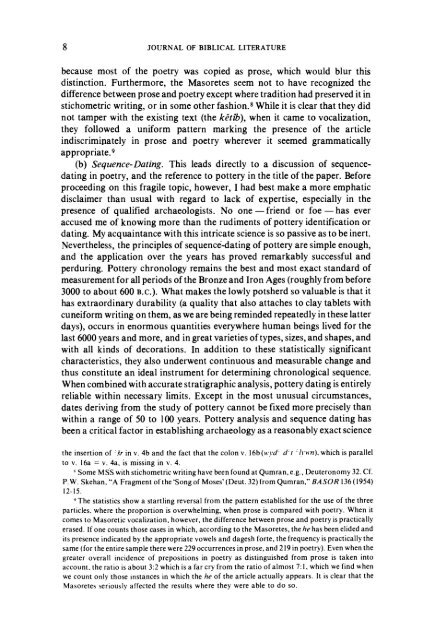POTTERY, POETRY, AND PROPHECY: AN ESSAY ON BIBLICAL ...
POTTERY, POETRY, AND PROPHECY: AN ESSAY ON BIBLICAL ...
POTTERY, POETRY, AND PROPHECY: AN ESSAY ON BIBLICAL ...
You also want an ePaper? Increase the reach of your titles
YUMPU automatically turns print PDFs into web optimized ePapers that Google loves.
8<br />
JOURNAL OF <strong>BIBLICAL</strong> LITERATURE<br />
because most of the poetry was copied as prose, which would blur this<br />
distinction. Furthermore, the Masoretes seem not to have recognized the<br />
difference between prose and poetry except where tradition had preserved it in<br />
stichometric writing, or in some other fashion.8 While it is clear that they did<br />
not tamper with the existing text (the ketib), when it came to vocalization,<br />
they followed a uniform pattern marking the presence of the article<br />
indiscriminately in prose and poetry wherever it seemed grammatically<br />
appropriate.9<br />
(b) Sequence-Dating. This leads directly to a discussion of sequencedating<br />
in poetry, and the reference to pottery in the title of the paper. Before<br />
proceeding on this fragile topic, however, I had best make a more emphatic<br />
disclaimer than usual with regard to lack of expertise, especially in the<br />
presence of qualified archaeologists. No one -friend or foe- has ever<br />
accused me of knowing more than the rudiments of pottery identification or<br />
dating. My acquaintance with this intricate science is so passive as to be inert.<br />
Nevertheless, the principles of sequence-dating of pottery are simple enough,<br />
and the application over the years has proved remarkably successful and<br />
perduring. Pottery chronology remains the best and most exact standard of<br />
measurement for all periods of the Bronze and Iron Ages (roughly from before<br />
3000 to about 600 B.C.). What makes the lowly potsherd so valuable is that it<br />
has extraordinary durability (a quality that also attaches to clay tablets with<br />
cuneiform writing on them, as we are being reminded repeatedly in these latter<br />
days), occurs in enormous quantities everywhere human beings lived for the<br />
last 6000 years and more, and in great varieties of types, sizes, and shapes, and<br />
with all kinds of decorations. In addition to these statistically significant<br />
characteristics, they also underwent continuous and measurable change and<br />
thus constitute an ideal instrument for determining chronological sequence.<br />
When combined with accurate stratigraphic analysis, pottery dating is entirely<br />
reliable within necessary limits. Except in the most unusual circumstances,<br />
dates deriving from the study of pottery cannot be fixed more precisely than<br />
within a range of 50 to 100 years. Pottery analysis and sequence dating has<br />
been a critical factor in establishing archaeology as a reasonably exact science<br />
the insertion of 'sr in v. 4b and the fact that the colon v. 16b(wld'd't i-wn), l which is parallel<br />
to v. 16a = v. 4a, is missing in v. 4.<br />
x Some MSS with stichometric writing have been found at Qumran, e.g., Deuteronomy 32. Cf.<br />
P.W. Skehan, "A Fragment of the 'Song of Moses' (Deut. 32) from Qumran," BASOR 136 (1954)<br />
12-15.<br />
" The statistics show a startling reversal from the pattern established for the use of the three<br />
particles, where the proportion is overwhelming, when prose is compared with poetry. When it<br />
comes to Masoretic vocalization, however, the difference between prose and poetry is practically<br />
erased. If one counts those cases in which, according to the Masoretes, the he has been elided and<br />
its presence indicated by the appropriate vowels and dagesh forte, the frequency is practically the<br />
same (for the entire sample there were 229 occurrences in prose, and 219 in poetry). Even when the<br />
greater overall incidence of prepositions in poetry as distinguished from prose is taken into<br />
account, the ratio is about 3:2 which is a far cry from the ratio of almost 7:1, which we find when<br />
we count only those instances in which the he of the article actually appears. It is clear that the<br />
Masoretes seriously affected the results where they were able to do so.
















